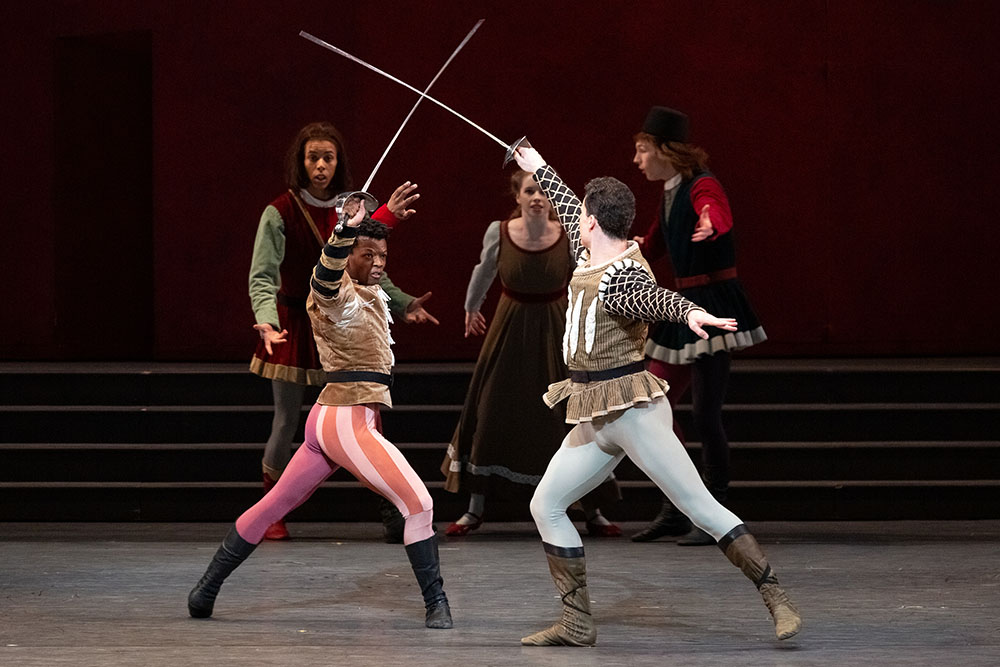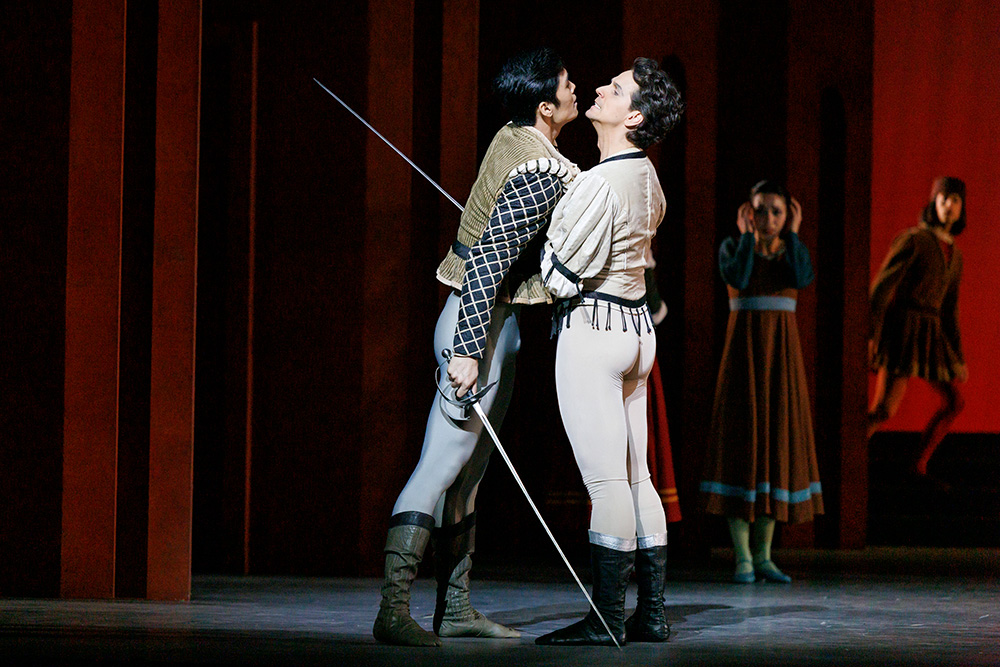Ballet
News+
Sword Dance: Fight Choreography in Romeo and Juliet
by Caroline Dickie
May 18, 2023

Siphesihle November and Piotr Stanczyk in Romeo and Juliet. Photo by Karolina Kuras.
The dazzling sword fights in Romeo and Juliet are not merely entertaining (although they are that, too). They help to situate the story in time and place, dramatize the individual quirks and familial tensions of the Capulets and Montagues and even contribute to the music, adding delicious cracks of metal to Sergei Prokofiev’s score. How do the dancers make stage combat look real while remaining safe, in character and – above all – performing the ballet’s challenging choreography? With the help of a fight coach.
Joe Bostick began his career as an actor for young audiences performing slapstick, gymnastics and other forms of physical theatre. Eventually he became a certified stage combatant and, in addition to acting, now works as a professional fight director and coach. For Romeo and Juliet, Bostick is working solely as a coach since Alexei Ratmansky choreographed the sword fights along with the rest of the ballet in 2011. Bostick’s role is to provide technical training on such things as body stance, weapon handling and safety.
“With swords, I always check to make sure the blade is connected to the hilt in the grip and the pommel is tight, that the blade is stage-worthy and not brittle,” he says. “I also provide instruction on eye contact and positioning.”
Fight coaches come from a variety of disciplines, from acting to martial arts, but all share a love of physical storytelling. Even in the absence of formal dance training, the physicality of stage combat aligns naturally with ballet, where the body is also a centre of meaning and communication. “Dancers are so aware of their bodies and the pictures they create onstage,” says Joe. “Telling a story through the illusion of violence is the same thing. The dancers are disciplined in their craft and they are able to bring that to the fighting.”
To the untrained eye, there is no single element or trick to making sword fighting look authentic, but rather a general sense of fluidity that emerges when the technique serves the drama. Great dancing is the same. “We have to see the story being told through the fight and through the sword,” Joe explains. “Who’s attacking? Who’s defending? What’s the intention of the person attacking? Do they want to make this a kill or are they just playing?”
Corps de Ballet member Peng-Fei Jiang is dancing the role of Tybalt, Juliet’s cousin and a skilled combatant. As Peng-Fei explains, Tybalt’s fighting style is an extension of his character – imposing, intense and aggressive. “Tybalt is a swordsman. He has a strong personality, so when I’m dancing I have to make everything bigger and bigger, especially during the fighting. I try to make every step and upper body movement as big as I can.”

Peng-Fei Jiang and Guillaume Côté in Romeo and Juliet. Photo by Bruce Zinger.
Famously, Tybalt deals a fatal blow to Mercutio, Romeo’s witty and freewheeling friend, a turning point that pushes the narrative toward tragedy.
Spencer and Peng-Fei are quick to identify similarities between sword fighting and the pas de deux, citing trust among partners and an emphasis on timing, pattern and space. But there are also distinct challenges in combining combat with ballet. “We need to know the choreography perfectly before getting on stage,” says Peng-Fei. “Otherwise, we’re going to hurt each other if we even miss one step. But once we’re used to the sword and the choreography, we can take the fight to the next level.”
“It can be a bit scary to wield a sword in the middle of intense dancing,” Spencer admits. “Dancers are inclined to think about steps and how things look. The angles of everything are important. There’s the sword fighting brain and the dancing brain, and hopefully they come together so it feels like one seamless thing. But it takes a lot of time to get there and a lot of practice and repetition.”
The fight coach’s job is to help synthesize the two disciplines. “Through rehearsal, the dancers become more comfortable with the swords and they’re able to bring intention to what they’re doing,” says Joe. “It’s what we call ‘acting the fight,’ and it’s what differentiates a good fight from one that just goes through the motions. I’m very excited to see this show and watch the story come to life.”
Romeo and Juliet is onstage June 15 – 25, 2023. Learn more